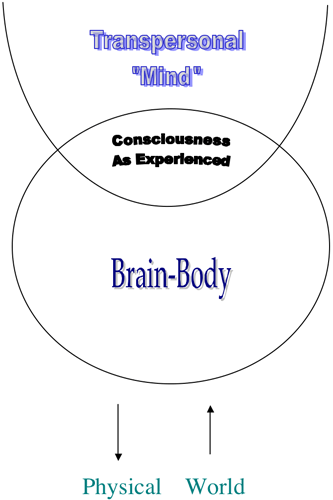|
|
|

|

|
|
Survival of Bodily Death Tart's Model of the Human Mind
Using sophisticated glasses containing TV screens and earphones, a computer generated virtual reality has been shown to be quite effective at producing a convincing experience of a "different world." Most people who have tried virtual reality have been able to easily enter into a very different experience of "reality." For example, people have reported very different experiences of gravity while immersed in a virtual world. The main point Tart made is quite simple, but profound: we are in a virtual reality all the time! In other words, the way we sense the world is constructed and semi-arbitrary. We do not have a simple perception of the world out there. The so-called "real world" is actually our own virtual reality. To give an example, Tart mentioned that humans see more visual separateness than there really is in the world. The edges of physical objects are enhanced in human vision to increase the discrimination of objects, so that we can navigate our world more effectively. Thus, our unique visual system does not allow us to see the world-as-it-is. Instead, asTart puts it, we are immersed in a bio-psychological virtual reality all the time that shapes and conditions the way we sense and experience the world. According to Tart's model, the interface between the transpersonal "mind" and our brain-body's computational assessment and virtual reality construction of the physical world results in consciousness as-we-experience-it. Our consciousness is not pure, and we don't see "reality" as it is. Rather, what we experience is a semi-arbitrary construction derived from the balance between the transpersonal mind and the brain-body to produce a virtual reality that we simplistically call "reality." This virtual reality is a good simulation of the physical world, so it works well most of the time for our practical purposes, but it isn't reality per se. After death, however, our brain-body are gone, so the consciousness we have after death is most likely very different from the embodied consciousness we experience now on earth. Tart said that the consciousness of dreams and sensory deprivation probably are closer to the consciousness we experience after bodily-death. Drug-induced experiences likewise are clues to what dis-embodied consciousness is like. Tart's main point is that we should not assume that the consciousness that survives death will be just like our current experience of consciousness, largely because it will be dis-embodied, without all the normal limits on our daily virtual reality we experience in embodied life on earth. Tart noted that people who have reported OBEs (out of body experiences) have quite similar experiences compared to normal life because our embodied habits are so strong. But people who have experienced repeated or extended OBEs often report that their experience begins to be limited less and less by the constraints and habits of the body-brain. Charles Tart’s Model |
|
|